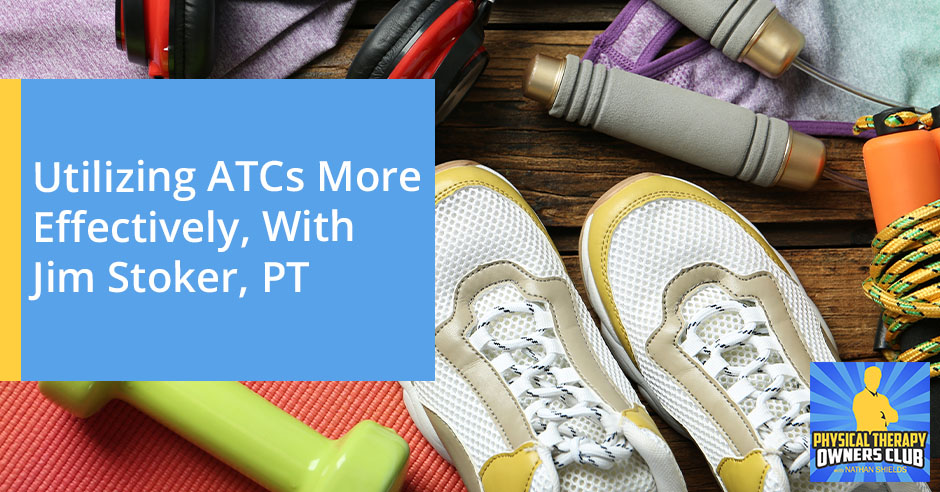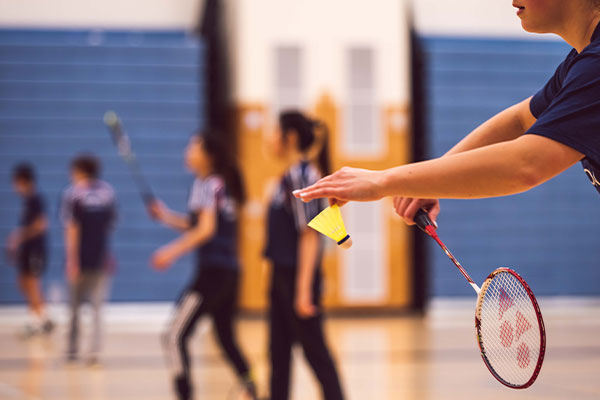
It’s not something you hear of every day, but many physical therapists collaborate with certified athletic trainers (ATCs) inside their clinics. Jim Stoker, PT is back on the show with Nathan Shields to share with us his secret for a more effective utilization of ATCs. From his 25+ years of experience working with ATCs in the past, he has found a way to use them in a way that is collaborative and a shared benefit to the community, and allows PT owners to not bear the financial burden. Taking a big step further from traditional collaborative paradigms, Jim co-created Play Safe, a nonprofit that accepts charitable contributions, employs the athletic trainer and then contracts and provides that athletic trainer to the high school.
—
Listen to the podcast here:
Utilizing ATCs More Effectively, With Jim Stoker, PT
I’ve got a returning guest, Jim Stoker. He is an Advisor at 8150 Advisors, a physical therapist, and also a past partner of Clemson Sports Medicine and Rehabilitation. I’m excited to bring him on this episode because he’s going to talk about a part of physical therapy that I’ve never talked about before in the years of doing the show with anybody. That is the utilization of athletic trainers in physical therapy clinics. I’ve got a little experience with it. We used one athletic trainer years ago, and it’s a great experience. I know there are plenty of physical therapists out there that might have athletic trainers on staff or are interested in going that path. Jim comes with a lot of experience in that. He’s developed a foundation to facilitate that. I’ll let him get into that. Jim, thanks for coming on again.
Thank you, Nathan. I appreciate that very much. My experience in outpatient orthopedic physical therapy is rooted in sports medicine. I mentioned in our last conversation, one of my partners Skip Hunter, but my other former partner, Neil Richardson, they started our clinics many years ago with a foundation in sports medicine. Some physical therapy owners may recall that there was a day in time many years ago, where you had a relationship with an athletic trainer that dropped by some high schools. It was an outreach to the community. It connected you with some physicians’ community. It was a nice thing to do. The whole reason those scenarios exist, if you drill down to why that started and why there remains a challenge now, in South Carolina and in our neighboring states, but typically taxpayer funds are not allocated from the state budgets to secondary schools, to high schools, and to employ certified athletic trainers.
There are some examples of school districts creating their own line item and allocating revenue to hire an athletic trainer for a school, but typically, taxpayer funds from the state level do not flow down to secondary schools to hire a trainer which I think is crazy. We have huge athletic programs like football. We know the risk of concussions. We know all those risks, but to provide the facilities, the equipment, everything that goes into an athletic department, and then neglect the healthcare that should accompany and provide a safe, healthy for children to participate. That frames the why behind Play Safe. Why does Play Safe exist?
It’s a community issue. To give you a little bit of the cliff notes story. The old scenario of one trainer stopping by schools quickly evolved to everyone understanding that every school needs an athletic trainer. It came to the point where one entity being Clemson Sports Medicine, or whoever in your own community, you can’t afford it. It becomes a donation to the community. Marketing is outreach, but it gets to a point where he can’t afford it. I, in conjunction with a number of local physicians, decided to come up with another solution where it’s like it’s too important to simply not do it to care about too much.
A lot of physical therapists might be in that same boat where they’ve got athletic trainers on staff. The backend proposition is that some of those injured athletes are going to come to you for physical therapy, but that’s a sizable investment in people, monies, and time that those athletic trainers to have to spend with the teams. It’s a significant outlay for an independent physical therapy owner to that kind of stuff because it’s not coming from the school districts. That can be difficult to handle. I love that you guys took it a step further with this organization.
Any business owner, a physical therapist that has been involved with sports medicine, if you’ve hired an athletic trainer, you’ll get a couple of athletes a year. There is no way in any scenario that I’ve been involved in years of outpatient orthopedic and sports medicine do you ever have a direct correlation of revenue coming in that’s going to pay for your expense of athletic training. It does not happen. There is an element of philanthropic donation to the community of marketing. Our region grew to the need and to the point where we could not afford it. We joined with a couple of local physicians that care about sports medicine, who understand how important it is for the children.
We honestly decided that this is a community problem and responsibility they don’t know about. We need to create a community solution, so we did. We created a nonprofit federally tax-exempt 501(c)(3) called Play Safe. It serves as a vehicle that concerned community members that care about the health and safety of their children playing high school athletics can contribute. Play Safe accepts charitable contributions, employs the athletic trainer, and then contracts and provides that athletic trainer to the high school. It’s a self-sustaining program.
The physical therapy clinic can contribute an appropriate terrible amount to our organization so can the doctor’s office and in the hospital, but you could also use that organization, Play Safe, as an educational tool to educate the community. Also, educate the moms and dads that, “The trainer that’s been standing there for many years, he’s not funded by your taxpayer dollars. It is by the generosity of John Smith, PT that has done that for years.” You can then educate the community and you can grow the grassroots support and provide a sustainable structure.
If I’m a pet owner in Arizona where my clinics were and I wanted to take advantage of this, maybe I have athletic trainers on staff and I would like to transition over to this, can I do it with PlaySafe.org and become part of that organization?
Logistically, across many state lines would be challenging, but you can. Play Safe, being a federal tax, we are in two states now. We’re in South Carolina and Georgia. There are an opportunity and a mechanism by which to do it across state lines.
If the physical therapist then simply wanted to do it themselves, you’re saying that it’s possible. They can create that 501(c)(3), make it a tax-exempt entity, and then solicit donations from various people in the community to support this athletic trainer. You’re still managing that per se. What does that level of management as you’re managing that 501(c)(3) on behalf of that athletic trainer?
Play Safe has agreements and contracts with 23 high schools. We have 31 athletic trainers on staff, and it’s always changing. We have one athletic trainer supervisor named Jasen Powell. We have an HR staff entropy who is a retired athletic director herself, who cares deeply about high school sports. We have a bookkeeper, accountant, executive director whose role is growth and development, raise funds, develop relationships, and spread the word. We’re in South Carolina and Georgia now. We’ve been approached by certain regions and we go have the conversation and explained to them how it works. We bring all the stakeholders to the table and say, “This is how much it’s going to cost year over year to support this system.” Honestly, the stakeholders get together and say, “What can you do?” Everyone pledges. You have the funds pledged to provide the service and off you go. You have to have the funds in place. Play Safe is not a foundation that has a big bank role that they can come in and just plug and play. It’s a proactive community solution that is housed and serves their own community.
What would you tell me as that Arizona physical therapist who sees that as an opportunity to benefit the community? Where should I start? It’s establishing the 510(c)(3), but where do I go from there?
Number one, they can contact me. They can get shoot me an email at Jim.Stoker@PlaySafeSC.org. You can go to our website, which is www.PlaySafeUSA.org. There are so many different moving parts and so many nuances with each community. The easiest way is to have a conversation.
The true benefit is that it becomes a community effort and not just the physical therapy clinics’ effort and burden necessarily. You get everybody playing together. You’re working in a situation where you are peer-to-peer with a physician rather than asking for referrals. You’re trying to get these guys on board and then what can we do for the community? It’s also something that you could do. Do you find yourself also working with other physical therapy clinics in the community? This isn’t you hiring and it’s your athletic trainer on your payroll. This is the community’s athletic trainer and we can do this together with other physical therapy clinics as well.

It has taken time. Play Safe was founded in 2011. Years later, we have physical therapy clinics that contribute to physician’s offices both orthopedists and primary care hospitals. There’s a general sense that you have a locally based nonprofit hospital, part of their mission is to serve the community. It’s a natural fit, but at the same time, you use Play Safe as an organization to promote. Don’t be afraid to promote the people that provide a fantastic service to your community. You have a central entity that can promote and thank the organizations. Being a high school is a tremendous amount of visibility to the community. We have construction, engineering firms, car dealerships, and accounting firms that all contribute to Play Safe to training. They can grow beyond the medical community.
It’s important to recognize that if a physical therapist hasn’t gone down the path of having an athletic trainer for the purposes of providing support to the local high school, it’s not altogether a huge return on investment. It’s usually a philanthropic effort. This is a way to still achieve that purpose that you’re wanting to achieve and provide a valuable service to the high school athletes without taking the financial punch.
It’s a constant challenge to educate. Concerned moms and dads in high schools turnover every year, but the athletic trainer has to be part of the organization. It takes a consistent and educational effort. There isn’t also an educational mission to Play Safe because we do collect injury reports and data. We believe that there is a larger responsibility to contribute to a body of knowledge about sports medicine injuries. It is fairly rudimentary. We’re not perfect. There are places that Play Safe can improve for sure, but we do track injuries. We believe there’s a responsibility to collect some of that data and as best as we can to try to contribute to that body of knowledge.
You’ve grown it to a point where you have 31 athletic trainers on indirectly now, but it sounds like it’s very doable for the singular practitioner or clinic owner to support 1 or 2 high schools in a valuable way. It doesn’t sound like it might be all that difficult.
Looking back, probably not. It takes work on the front end. You have to build the coalition, the collaborative group that cares and that is committed. It has been a rewarding way to connect and further strengthen your network. People that care, you’re working towards a common goal across professions, and in many times across industries. There’s a lot of work on the front end.
What’s cool is if you are thinking about how this might benefit your clinic, many times, we do want to provide this benefit to the community, but something that might be refreshing if it were me is, I’m talking to physicians even hospital administrators, and other in the community, not from a point of, “Send me your business.” It is not from a position where I want something from them, but simply educating and more so inviting, like, “Here’s this separate third party, the athletic trainers and our high school athletes that I’m trying to help. Maybe if we work in this collaborative way can help this third party.” It’s nice to have that conversation more so than the typical, “Can you send me a referral?” type of thing.
It’s a mechanism to build relationships. It is a common ground to develop relationships and to achieve a common goal. Physical therapy owners know that it is important to establish and foster relationships in your community, be it through your referral network or your chamber of commerce, but it’s a commonality that will help develop relationships for sure.
You already shared your email information. What was the website again?
The website is www.PlaySafeUSA.org.
Please share your email address again.
It’s Jim.Stoker@PlaySafeSC.com.
I invite physical therapists that are interested in athletic trainers, employing them and creating an 510(c)(3) to reach out to you. Thank you for being available in that regard.
It is a pleasure. Thank you. It’s a challenge, but it is a lot of fun.
Thanks for joining me again, Jim and I invite everybody, if you want to learn more about Jim, I did another episode with him where we talked about establishing goals, especially we’re talking about goals to look back on, reassess and also for the future. He provides a ton of great information and wisdom. Thank you for being part of both of these episodes, Jim. I appreciate it.
It’s my pleasure. It was a lot of fun. Thank you, Nathan.
Important Links:
About Jim Stoker
 Jim has over 25 years of management and leadership experience in the healthcare industry and is passionate about helping owners reach their full potential. Jim specializes in strategic growth and clinic optimization of key performance indicators and clinic metrics achieved by creating an engaged employee culture of teamwork, excellence, accountability, and leadership development.
Jim has over 25 years of management and leadership experience in the healthcare industry and is passionate about helping owners reach their full potential. Jim specializes in strategic growth and clinic optimization of key performance indicators and clinic metrics achieved by creating an engaged employee culture of teamwork, excellence, accountability, and leadership development.Love the show? Subscribe, rate, review, and share!
